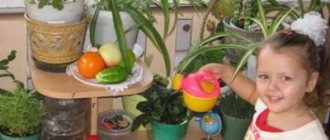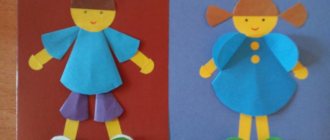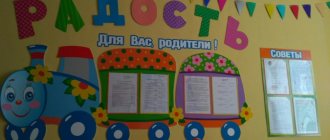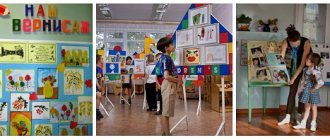Methodological office at the preschool educational institution
Methodological classroom in preschool educational institution
A methodological office in a preschool institution is created in order to provide daily targeted methodological assistance to educators in the implementation of the program according to which the institution operates, in preparation for the working day, for the pedagogical council or parent-teacher meeting, for self-education classes, etc.
When organizing the work of the methodological classroom, the senior educator must focus on the needs of teachers when selecting content and design. The office usually contains information about the institution and author's developments, an annual plan, materials from pedagogical councils, orders, methodological letters, recommendations, materials from the work experience of educators, music directors, and speech pathologists; calendar plans, notes and minutes of discussion of open viewings of classes, games, work activities, walks, etc.; holiday matinee programs; materials for consultations and thematic exhibitions for parents, etc. Visual teaching aids, handouts, and technical teaching aids for all sections of the program in which the kindergarten operates are also stored here, which allows them to be used in different classes in different age groups.
All material located in the methodological room can be divided into several groups (Fig. 1).
1. Regulatory and instructional materials.
2. Methodological literature.
3. Reference literature.
4. Didactic materials.
5. Technical training aids.
6. Visual materials.
The methodological office should have a library - a collection of methodological and children's fiction. The library may include books in the following sections: pedagogy and psychology, methods of teaching and raising children, family education, joint work with school, reference books, magazines on preschool education. It is advisable to systematize methodological literature on certain issues of education, for example, “Physical development”, “Moral education”, “Game”, “Speech development”, “Everything about nature”, “Musical development”, etc. d. A special department containing the works of classics of pedagogy and psychology is also necessary in the methodological classroom. It can be based on collected works or selected works by L. A. Wenger, L. S. Vygotsky, I. A. Komensky, J. Korczak, V. A. Sukhomlinsky, K. D. Ushinsky, D. B. Elkonin and other prominent scientists,
In the “Reference Literature” section you can place various encyclopedias and reference books. To improve the speech culture of kindergarten workers, dictionaries can be used as reference books: “Explanatory Dictionary of the Russian Language” by V. I. Dahl, “Dictionary of the Russian Language” by S. I. Ozhegov, dictionary-reference book “Russian Literary Pronunciation and Stress”, “ Pedagogical Dictionary”, “Dictionary of Ethics”, etc. A significant place in the methodological classroom is given to professional periodicals, such as “Preschool Education”, “Child in Kindergarten”, “Reference Book”
senior teacher of a preschool institution”, “Preschool education”, “Kindergarten”, “Family and school”, “Nanny”, “Our baby”, etc.
In addition, here we need documents defining the nature of the activities of teachers: “International Convention on the Rights of the Child”, the Law of the Russian Federation “On Education”, “Model Regulations on a Preschool Educational Institution in the Russian Federation”, etc., with which all employees of the childcare center should be familiar garden
The library of children's fiction should primarily include works recommended by the program in which the kindergarten operates. Then this section is supplemented by collections of fairy tales, small folklore forms, educational literature, works of Russian and foreign poets and writers. You can arrange children's books in alphabetical order or by age. So that teachers do not spend a lot of time searching for the right book, it is best to create bibliographic lists or catalogs on topics (about the homeland, about nature, about technology, etc., by sections, methods, individual problems. It is also important to introduce a systematic catalog of books for children of preschool age. It is better to make catalogs electronic, for example, in the form of a database. To do this, you can purchase special programs for working with the library, allowing you to create an alphabetical, systematic catalog, easily and quickly search for the books you need or select a list of literature on a topic.
Currently, if there is a computer in the teaching room, a senior teacher can create an electronic library of teaching materials, manuals, and works of art for children. This will allow each teacher to use the benefit that he needs at any time, even if it is handed out in printed form. Using the Internet will allow the head and senior teacher to always be aware of the latest technologies in the field of preschool education, and get acquainted with the experience of kindergartens throughout Russia and abroad. Now almost every kindergarten has its own website, where
materials about the life of a particular institution are posted, which makes it possible to most successfully present the work of the institution, makes it open to the parent community, causing a desire to work better and achieve significant results.
The head assists the senior teacher in the design of periodic exhibitions on the most pressing problems of education and training, on which the teaching staff works during the academic year. Exhibitions introduce new pedagogical, methodological and children's literature, new manuals and toys. You can also organize exhibitions reflecting educational work in different seasons of the year. They can present seasonal calendars of nature, approximate plans for walks and excursions, recommendations for working with children of different age groups on the site and in a corner of nature, illustrative and visual material, works of art for reading to children.
Exhibitions can be permanent or occasional. Permanent exhibitions are, for example, such as “New Literature”, “Our Calendar”, “Introduce Children to Nature (by Season)”, “To Help the Educator (Self-Education)”, etc. Only the name of the section is permanent, but the material and contents change.
The episodic exhibitions include the following: “Studying the pedagogical heritage”, “Getting acquainted with the work of a writer (artist, musician, etc.)”, “Entertaining psychology”, “Preparing for a review-competition” (certification, final classes, etc.); “Alternatives” (about different programs and advanced technologies for the development of preschool children) and many others, the need for which arises during the school year.
The topics of exhibitions can be varied, but when designing them it is important to follow some recommendations:
- if there is a normative or instructional document (regulations, instructions, etc.) on the topic submitted, then a plan for its study, recommendations for teachers on working with it, experience of working with this document in other kindergartens, etc. must be presented;
— methodological recommendations on this topic;
- work experience related to this topic (kindergartens in your city, other cities, foreign countries);
- literature on this topic (you can give a list with a brief annotation or a card index);
— visual material related to this issue: list of equipment, diagrams, drawings, samples of crafts, paintings, slides, videos, etc.
To account for all materials, an inventory book (or its electronic equivalent) is created in the methodological office, in which the name of the material (book or manual), date of receipt, and the section where new material is placed are recorded.
The head, together with the senior teacher, needs to analyze the teachers’ use of the materials available in the office, discuss with employees what really helps them in improving the teaching process, and what needs to be changed, replenished, etc. It is important to ensure that the methodological office effectively influences the improvement quality of educational and methodological work.
The work of the methodologist is to select for each teacher from the mass of available book stock the literature that will provide him with the necessary assistance in preparing for
pedagogical council, for a lesson, for a parent meeting, for self-education or generalization of experience. For this purpose, appropriate annotations are drawn up for articles in journals, books, and the necessary recommendations and instructions for working with literature are developed. It is advisable to organize work in the classroom in such a way that educators can work with books there, get advice, so that each visit to the teaching classroom brings them new knowledge, new thoughts, and enriches their experience. To do this, the room must be prepared accordingly: it is necessary to arrange comfortable tables and chairs, organize a place to work at the computer, place a soft corner with tea attributes.
In addition to everything discussed, it is advisable for the senior teacher in the teaching room to constantly present new material from various sources, attracting the attention of teachers to the problems of education and training, helping to prepare for competitions, informing about events, changes in preschool education, making them think about pedagogical situations, reflect on their work.
In addition, in the methodological office you need to collect a sufficient amount of materials on working with parents. This is due to the fact that teachers in groups need to have visual and textual material to conduct pedagogical education of parents. This often causes certain difficulties: educators cannot always methodically and competently change such material depending on the season, the topic of parent-teacher meetings, etc., its nature is most often quite monotonous, and, as a result, it does not achieve the main goal: parents they don’t get to know him.
The help of the senior educator is to teach educators to use the minimum amount of time with the greatest impact when preparing material for parents. Such material can be concentrated under different headings: “Doctor's advice?), “For parents about physical education,” “Why does the child not obey,” “Gifted children,” “Summer is coming,” etc. Several may be developed on the same topic materials, for the preparation of which it is necessary to involve educators engaged in self-education, preparing a report on their activities or getting acquainted with work experience, preparing for events for parents. This form of work may be of interest to parents who read bright, aesthetically designed, useful material, where topical issues of family education, health problems, child development, readiness for
school, assignments were given to observe various manifestations of the child, statements and stories of children, and much more. Information can be changed in each group daily, weekly, monthly. All this helps to establish feedback between parents and educators, prepare for consultations, workshops, business games and other non-traditional forms of working with families.
When organizing the materials of the teaching room, it is important to listen to the opinions of the educators for whom it was created. It is necessary to analyze the nature of teachers’ requests to the senior educator regarding certain materials; which benefits are used more often, which ones are not used at all; which of the educators constantly uses literature, manuals, which rarely, etc. The facts for such an analysis will be provided by a notebook (diary, journal) for issuing teaching aids, which is kept in handwritten, electronic or printed form in the office. The preschool institution must draw up a work schedule for the teaching room, which specifies the time for issuing literature and manuals. This time is selected in such a way that teachers working both the first and second shifts can use the services of the office.
In order to successfully solve problems related to providing methodological assistance to educators, improving their qualifications and general educational level, it is necessary to select material for the classroom that meets modern methodological requirements and carefully consider its systematization.
If all these conditions are taken into account, then the methodological room in a preschool institution will be of great benefit in the process of improving the skills of employees, team building in solving specific tasks formulated in the Charter, development program and annual plan of the preschool educational institution.
It is important to remember that the true assessment of the effectiveness of methodological work is given by the final result, and not by the number of different
carried out events. In addition, the leadership style and methods they choose have a significant impact on the results of management activities of the senior teacher and head.
The methodological room has a multifunctional purpose: it is a place where methodological materials of preschool educational institutions are collected in all areas of development of preschool children; the best work experience of teachers at their preschool educational institution and other kindergartens; scientific and methodological literature on many problems of preschool educational institutions and more. On the other hand, a teaching room can be called a creative workshop, where a teacher can receive specific practical assistance in organizing work with children. The methodological office is a center for collecting pedagogical information (regulatory documents, pedagogical and methodological literature, best pedagogical experience).
Rules for the functioning of the methodological office
1. An important condition for the high effectiveness of the educational process is the constant, timely informing of teachers about new developments in psychological and pedagogical science and best practices, about the legal and methodological support of the preschool education system. At the same time, the methodological office should contain information about your institution and author’s developments. Here is a development plan for the institution, an annual plan, and materials from teachers' councils. Thematic exhibitions are regularly organized, which should not be static, but should change more often under different headings that attract the attention of educators.
2. The teaching room should be accessible to every educator, have a convenient, flexible work schedule, meetings, seminars, and consultations.
3. All design must be done in the same style, tasteful, conducive to conversation and creative work.
4. There are guests and colleagues in the kindergarten, and parents come every day. And for them, the office must have comprehensive information.
5. The experience presented in the classroom should “provoke” teachers to creativity and encourage them to improve their professional skills.
Cabinet equipment
The methodological office has a room in which the teaching and methodological activities of the team are carried out, as well as methodological and reference literature.
The office is equipped with:
- — bookcases that contain regulatory and instructional documents, methodological and children's fiction, didactic materials, and audiovisual aids.
- — desks, chairs, for organizing and conducting teacher councils, seminars, methodological associations and other forms of work.
- - computer
- - scanner
- - Printer
Methodological support
• Information and analytical department. Materials on certification, advanced training, comprehensive assessment of teaching activities. Monitoring and analyzing the state of the educational process, its quality. Assessing the effectiveness of the pedagogical process in preschool educational institutions.
• Department of software and methodological support. Educational programs implemented in preschool educational institutions; alternative educational programs; thematic planning according to the program “From childhood to adolescence”; methodological literature on psychology;
• Department of artistic and aesthetic development. Methodological literature, lesson notes, consultations on artistic activities, design, manual labor; Information about artists, reproductions of paintings; Information and samples on folk art, folk toys;
• Department of Physical Development. Methodological literature and development of notes, consultations on physical education and children's health; literature on valeology, encyclopedias (physical education, anatomy, human structure). This department contains literature, methodological developments, workbooks, and video materials for working with children on life safety.
• Fiction department. Collections and individual works of children's and fiction literature; Scientific and methodological magazines, booklets.
• Department of social and personal development. Methodological literature, development of notes, consultations on familiarization with the native land, the Republic of Khakassia. Literature for the implementation of the national-regional component in preschool educational institutions (fiction, teaching aids, visual and illustrative material).
• Department of cognitive and speech development. Methodological literature, development of notes, consultations; Children's encyclopedias, visual and illustrative material.
• Department for work with parents. Information on general problems of raising children, preparing children for school, and protecting the rights of the child. These are: normative documents, methodological literature, developments of consultations, conversations, visual and illustrative material related to these topics. Materials on protecting the rights of the child.





